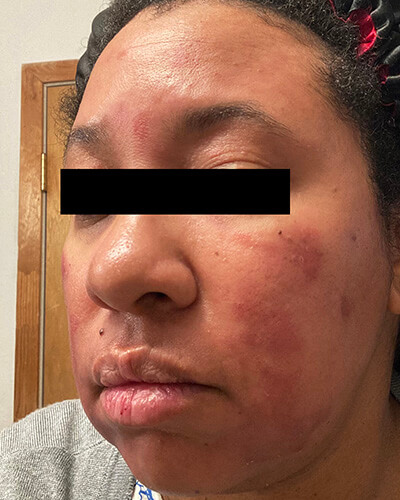 While rosacea is typically thought of as a disorder that affects people with light complexions, it occurs in people with darker skin as well. An analysis of data from the National Ambulatory Medical Care Survey found that of all patients diagnosed with rosacea, 3.9% were Hispanic or Latinx of any race, 2.3% were Asian or Pacific Islander, and 2.0% were Black.1 The researchers noted that people of color were less frequently diagnosed with rosacea even when they came in for the same exact reasons that led to the diagnosis for white patients.
While rosacea is typically thought of as a disorder that affects people with light complexions, it occurs in people with darker skin as well. An analysis of data from the National Ambulatory Medical Care Survey found that of all patients diagnosed with rosacea, 3.9% were Hispanic or Latinx of any race, 2.3% were Asian or Pacific Islander, and 2.0% were Black.1 The researchers noted that people of color were less frequently diagnosed with rosacea even when they came in for the same exact reasons that led to the diagnosis for white patients.
“Rosacea is underrecognized and underreported in skin of color, and part of that is because it’s harder to diagnose,” said Dr. Nada Elbuluk, associate professor of dermatology at the USC Keck School of Medicine, in a presentation at the 2022 American Academy of Dermatology annual meeting. “The erythema and telangiectasias that we expect to see are masked by melanin, so they’re harder to pick up. Unfortunately, when these diagnoses are missed or delayed it can have downstream consequences for the patient, including more severe signs and symptoms, ocular rosacea, and decreased quality of life.”
What appears as a persistent redness in light skin may instead be perceived as brownish or violet undertones in darker skin types, and the tiny blood vessels known as telangiectasia may be harder to see.
In patients with bumps and pimples, the lack of comedones (blackheads and whiteheads) differentiate rosacea from acne, Dr. Elbuluk said. She also noted that phymatous rosacea, the skin thickening which often results in a bulbous appearance to the nose, in its earliest stages may be most noticeable on the ala, the area surrounding the nostrils, in patients of color.
To aid in diagnosis, Dr. Elbuluk recommended that taking photos of patients in strong light against a black or dark blue background may help make redness stand out more. A technique called diascopy, in which a clear glass or plastic slide is pressed against the skin to blanche it, can make it easier to detect telangiectasia. Symptoms of burning, stinging and itching also help point to a rosacea diagnosis, as can a family history of rosacea. She observed that while patients of color often experience post-inflammatory hyperpigmentation (PIH) from acne, PIH does not tend to result from the bumps and pimples of rosacea.
Dr. Elbuluk noted that many patients of color use lightening agents, which often contain topical corticosteroids. Overuse of these products can cause signs and symptoms that mimic rosacea, including redness, burning and stinging, and pimples. Treatment for so-called “steroid-induced rosacea” is a gradual weaning off of the product, often with the use of topical and/or oral anti-inflammatory medications.
Reference:
1. Al-Dabagh A, Davis SA, McMichael AJ, Feldman SR. Rosacea in skin of color: not a rare diagnosis. Dermatol Online J 2014 Oct 15;20(10):13030/qt1mv9r0ss. PMID: 25526008.